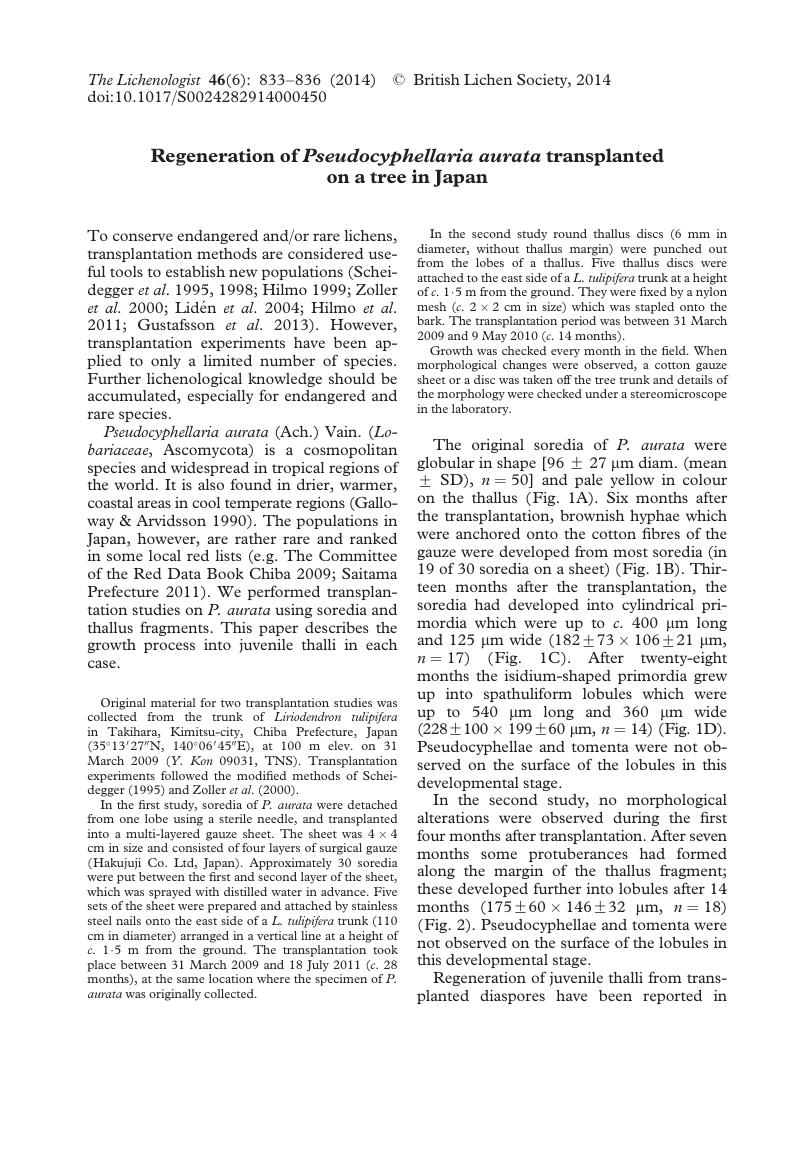Crossref Citations
This article has been cited by the following publications. This list is generated based on data provided by Crossref.
Lendemer, James C.
2016.
Recent literature on lichens—240.
The Bryologist,
Vol. 119,
Issue. 1,
p.
107.
Allen, Jessica L.
2017.
Testing lichen transplant methods for conservation applications in the southern Appalachian Mountains, North Carolina, U.S.A..
The Bryologist,
Vol. 120,
Issue. 3,
p.
311.
Wijayawardene, Nalin N.
Hyde, Kevin D.
Rajeshkumar, Kunhiraman C.
Hawksworth, David L.
Madrid, Hugo
Kirk, Paul M.
Braun, Uwe
Singh, Rajshree V.
Crous, Pedro W.
Kukwa, Martin
Lücking, Robert
Kurtzman, Cletus P.
Yurkov, Andrey
Haelewaters, Danny
Aptroot, André
Lumbsch, H. Thorsten
Timdal, Einar
Ertz, Damien
Etayo, Javier
Phillips, Alan J. L.
Groenewald, Johannes Z.
Papizadeh, Moslem
Selbmann, Laura
Dayarathne, Monika C.
Weerakoon, Gothamie
Jones, E. B. Gareth
Suetrong, Satinee
Tian, Qing
Castañeda-Ruiz, Rafael F.
Bahkali, Ali H.
Pang, Ka-Lai
Tanaka, Kazuaki
Dai, Dong Qin
Sakayaroj, Jariya
Hujslová, Martina
Lombard, Lorenzo
Shenoy, Belle D.
Suija, Ave
Maharachchikumbura, Sajeewa S. N.
Thambugala, Kasun M.
Wanasinghe, Dhanushka N.
Sharma, Bharati O.
Gaikwad, Subhash
Pandit, Gargee
Zucconi, Laura
Onofri, Silvano
Egidi, Eleonora
Raja, Huzefa A.
Kodsueb, Rampai
Cáceres, Marcela E. S.
Pérez-Ortega, Sergio
Fiuza, Patrícia O.
Monteiro, Josiane Santana
Vasilyeva, Larissa N.
Shivas, Roger G.
Prieto, Maria
Wedin, Mats
Olariaga, Ibai
Lateef, Adebola Azeez
Agrawal, Yamini
Fazeli, Seyed Abolhassan Shahzadeh
Amoozegar, Mohammad Ali
Zhao, Guo Zhu
Pfliegler, Walter P.
Sharma, Gunjan
Oset, Magdalena
Abdel-Wahab, Mohamed A.
Takamatsu, Susumu
Bensch, Konstanze
de Silva, Nimali Indeewari
De Kesel, André
Karunarathna, Anuruddha
Boonmee, Saranyaphat
Pfister, Donald H.
Lu, Yong-Zhong
Luo, Zong-Long
Boonyuen, Nattawut
Daranagama, Dinushani A.
Senanayake, Indunil C.
Jayasiri, Subashini C.
Samarakoon, Milan C.
Zeng, Xiang-Yu
Doilom, Mingkwan
Quijada, Luis
Rampadarath, Sillma
Heredia, Gabriela
Dissanayake, Asha J.
Jayawardana, Ruvishika S.
Perera, Rekhani H.
Tang, Li Zhou
Phukhamsakda, Chayanard
Hernández-Restrepo, Margarita
Ma, Xiaoya
Tibpromma, Saowaluck
Gusmao, Luis F. P.
Weerahewa, Darshani
and
Karunarathna, Samantha C.
2017.
Notes for genera: Ascomycota.
Fungal Diversity,
Vol. 86,
Issue. 1,
p.
1.
Leddy, Nadine
Blanchon, Dan J.
Wiapo, Charmaine
Eruera, Tamia
Cameron, Kristie E.
and
Kahui‐McConnell, Richelle
2019.
Artificial dispersal of the lichen Crocodia aurata (Lobariaceae) using asexual propagules and gel‐filled gauze packets.
Ecological Management & Restoration,
Vol. 20,
Issue. 2,
p.
119.
Giordani, Paolo
Benesperi, Renato
Bianchi, Elisabetta
Malaspina, Paola
and
Nascimbene, Juri
2020.
Environmental Concerns and Sustainable Development.
p.
1.
Olariaga, Ibai
Paz-Bermúdez, Graciela
Calvo, Javier
Etayo, Javier
and
Prieto, María
2020.
Rediscovery of the endangered lichen Pseudocyphellaria aurata (Lobariaceae, Ascomycota) in mainland Spain.
Anales del Jardín Botánico de Madrid,
Vol. 77,
Issue. 2,
p.
e099.
Bjelland, Torbjørg
2023.
Practical conservation action on a Critically Endangered lichen species.
Journal for Nature Conservation,
Vol. 75,
Issue. ,
p.
126474.



